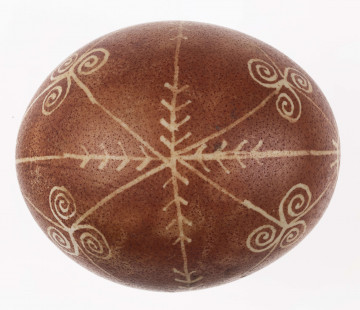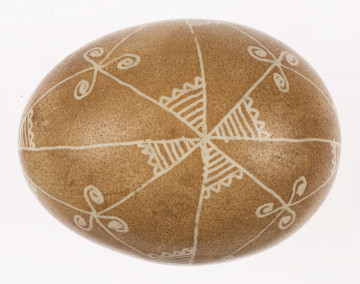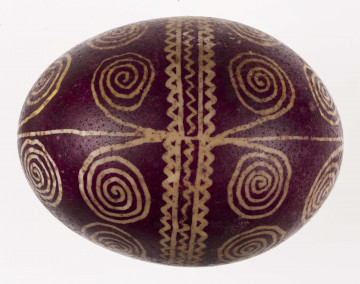
Easter egg
1901 — 1920
National Museum in Lublin
Part of the collection: Folk Art of the Lublin Region (17th–1st half of the 20th c.)
The egg was a symbol of life, fertility, love and strength, and the symbolism of ornaments written on it played an important magical role. In the Lublin region, eggs were most often decorated using the batik technique, which involved writing on a pattern with melted wax with the help of a marker made of sheet metal in the form of a funnel set on a stick. The technique of etching or scratching was also used (see E/1038/ML). In earlier times, natural vegetable dyes were used, including those made from onion skins, beetroot juice, oak bark, fork seeds or young rye shoots (see also E/1117/ML).
One of the written ornamental motifs was a triskelion (triskele) or in other words trojak, similar in form to an inverted Y. It is a sign composed of three identical elements: arms, spirals, meanders, etc., forming a cyclic geometric pattern. It pointed to the eternal cycle of life, the triple feminine aspect (virgin, mother, old woman), the three stages of life (youth, adulthood, old age), the three forms of the material world (earth, sea, sky). It already appeared in ancient art. Many astrologers also considered it a symbol of the sun. It was one of the main symbols of the ancient Slavic faith. It was used to decorate stone circles, megaliths and other sacred places of worship, as well as sacrificial vessels. In Polish folk ornamentation it has been preserved as a reminiscence of old magic signs and incantations.
In the ethnographic collection of the National Museum in Lublin there are about 2500 Easter eggs made by artists from the Lublin region. Most of them were made in the years 1950-1980, while a significant number (around 500), unfortunately of unknown authorship, date from the early 20th century. The presented Easter egg belongs to the group of the oldest ones.
Author / creator
Dimensions
cały obiekt: height: 5,5 cm
Object type
Easter egg
Technique
batik
Material
wax, egg, plant-based pigment,
Creation time / dating
Creation / finding place
Owner
The National Museum in Lublin
Identification number
Location / status

1901 — 1920
National Museum in Lublin

1901 — 1920
National Museum in Lublin

1901 — 1920
National Museum in Lublin
DISCOVER this TOPIC
Museum of King Jan III's Palace at Wilanów
DISCOVER this PATH
Educational path